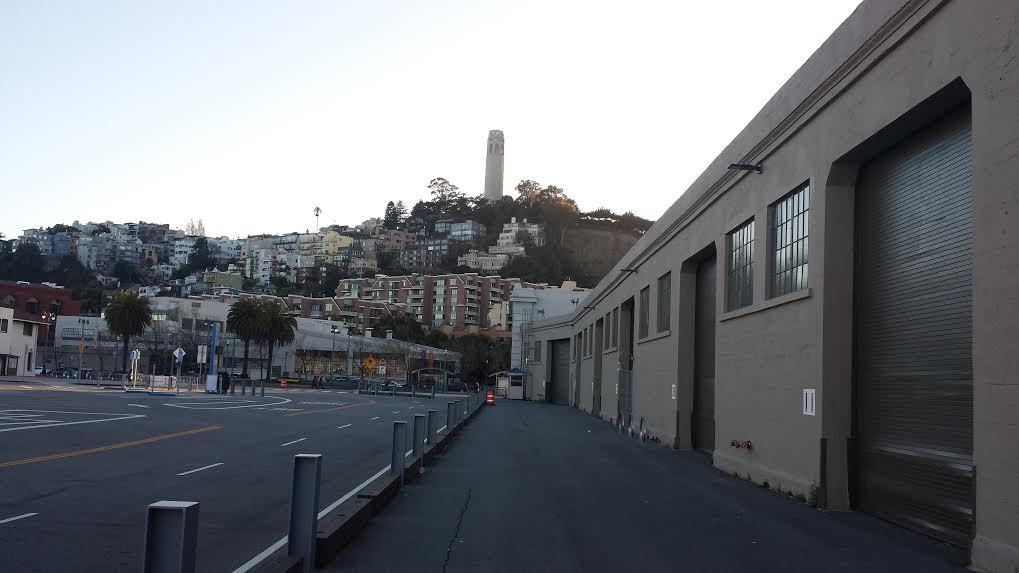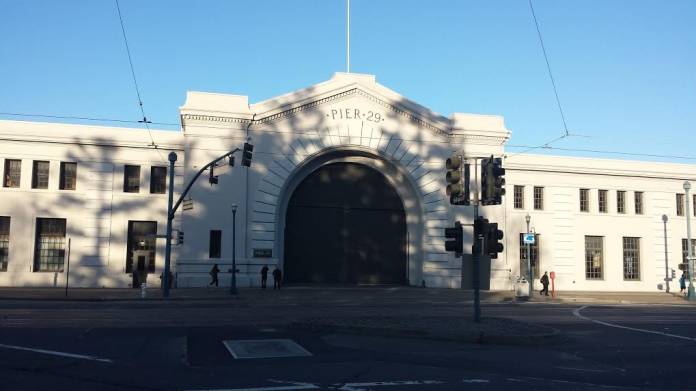There’s been a lot of press around the battle over a fairly small project on Pier 29. The Ex made it a cover story a few weeks ago, using the “No Mall on the Waterfront” line that opponents have developed. It was on the front page of the Chron today. A number of community groups are opposing it, and other support it, and a Board of Supes committee will hear heated testimony on it Thursday/2.
All for a project of about 22,000 square feet that is mostly small retail and food and drink and would feature locally-made products.
But there’s more to this development than some fancy beer and wine and some boutique SFMADE products. Once again, the Port Commission has decided to use waterfront property for commercial development in a way that defies existing waterfront plans and goals. Once again, critics are asking for something more oriented to the public, particularly recreation.
And once again, the Port of San Francisco seems unable to deal with the larger issue: Do we want the waterfront to be all private, pricey development, or do we want it to benefit the public?
The waterfront is a stunning, priceless public asset that needs some investment. Why aren’t we willing to pay for it?
Pier 29 hasn’t been a working pier in quite some time. It used to house Teatro ZinZanni, then was badly damaged by fire before becoming part of the America’s Cup extravaganza. The Port allowed a short-term popup restaurant, then decided that food and drinks with some retail would be a great use for the rebuilt bulkhead area on the Embarcadero, and asked for proposals.
Jamestown, which operates a commercial office building pretty much across the street at 1700 Montgomery, was happy to bid. It’s not a huge financial investment – less than $6 million, Remy Monteko, vice president for asset management, told me.
But it fits in nicely with the property the company already owns. There aren’t a lot of cool restaurants or bars near the Jamestown building, she said; “we want to amenitize the area.”
I don’t think “amenitize” is actually a word, but you get the point: The project at Pier 29 might make Jamestown some money, but it will absolutely make the 1700 Montgomery building more valuable.

Opponents say that the project doesn’t meet the goals of the existing Waterfront Land Use Plan, which says that public access to the water and recreational uses are a priority. The plan calls for a project on Pier 29 that “could provide a venue for all San Franciscans and Bay Area residents to actively participate individually or as groups, in diverse amateur recreation sports, physical fitness and related activities while enjoying the scenic waterfront setting.”
Now that Pier 27 has become a cruise terminal, “Pier 29 is one of the last places we have left for recreational use” on the Northern Waterfront, Jon Golinger, who is leading opposition to the project, told me.
The site, he said, would be perfect for a project like Chelsea Piers created in New York – a waterfront recreation complex. The Port and Chelsea actually discussed something like this more than 20 years ago, but then-Mayor Willie Brown favored a shopping mall instead. Waterfront advocates fought the ridiculous mall concept, and we ended up with nothing.
I asked Monteko, who grew up in Russian Hill and lives in North Beach, about the prospect of an entertainment complex. She said that she wasn’t sure it would pencil out – but more important, she said (accurately) that the Port didn’t ask for proposals for recreation. The Port wanted food and beverage with some retail; that was Jamestown responded to.
Now: The Pier is a big place, and the bulkhead area only covers about ten percent of it. But it’s a crucial ten percent: It’s the front door, so to speak, and it’s the area that the city has already paid to rebuild after the fire.
There are seismic issues still, and the Port hasn’t fully addressed them. But the rest of the pier will need far more work, and if Jamestown takes the prime, most valuable, and easiest part, finding someone who could create recreational uses on the remaining area will be that much harder.
And while I fully appreciate the effort to make this a local-merchant and maker facility, we need to be honest: All of the tenants that Jamestown will bring in will be high-end, boutique operations.
I asked Monteko if she had a project-labor agreement, and she said it was too early, but “we will do whatever is necessary.” The company has had labor problems in the past, and has a history of gentrifying areas where it does business.
This isn’t going to be a huge moneymaker for the Port, considering how much cash the city has already spent repairing and upgrading the pier after the fire. The term sheet calls for $25,000 a month in rent, which isn’t a whole lot more than the Port can get by using the site (as it is now) for storage and parking.
And the term sheet calls for a 15-year lease. That, Golinger said, is too long: If Jamestown wanted to do another “popup” for five years or so, while the Port figures out how to create a real recreational facility, that might be fine.
But Monteko was clear to me: Jamestown is not going to invest $5.8 million in the site without a 15-year deal.
The Board of Supes Budget Committee will look at the term sheet Thursday. If the supes sign off, then the Port and Jamestown will take a final pass, and the project will move onto the next phase. Monteko said she doesn’t expect a full environmental impact report would be required – and if that’s a mandate, “we would have to look at the feasibility of the project.”
The big issue here isn’t just the term sheet, or Jamestown’s record, or the finances, which are not entirely to the city’s favor. The question is why, once again, the Port seems to favor tourist uses (and this would attract tourists from Pier 39 and is right next to the cruise terminal) and upscale commercial activity over waterfront uses that might benefit people who live here.
The Port is public land. At some point, we have to decide as a city whether we are going to continue to use it as commercial real estate that has nothing to do with the waterfront. The Jamestown project could sit anywhere in San Francisco; does it really belong on the very rare and limited space where the city meets the Bay?
The mayor, I am told, is thinking about putting a bond act on the ballot in 2018 to repair, upgrade, and reinforce the aging piers against earthquakes and rising tides. That’s nice, but there’s more: For decades, the Port of San Francisco has looked at its property as developable real estate. At what point do we say that a city as rich as San Francisco should find ways to take what’s left of the waterfront and use it for the public interest?
Why are we rushing to approve a long-term deal when, for $6 million (which is, frankly, a tiny fraction of the city’s budget) San Francisco could start developing Pier 29 as a public, not a private, project?
The Jamestown plan is not the worst thing that’s ever been proposed (Willie Brown’s mall was far worse). But that’s not the point. It’s our waterfront. If we (as the Waterfront Land Use Plan says) want recreation on Pier 29, why can’t we have it? Is everything about whether a project pencils out for a private developer?
At what point are we willing to say that, just as Golden Gate Park isn’t (mostly) a commercial venture, some of the Port land should be set aside for public use, at public expense?
That’s the deep issue that’s hiding in this debate.





